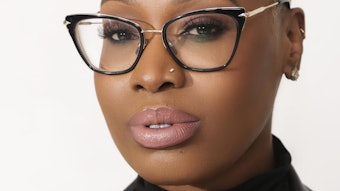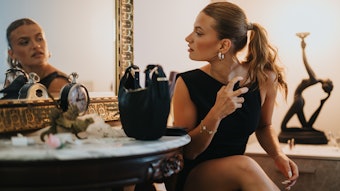Editor's note: For information on trends in color cosmetics from the male perspective, check out "Man Up" here.
- Younger consumers aren’t afraid of bold, intense color, and they are mixing more tints and shades for a myriad of color opportunities.
- Technology is helping consumers get more personalized and customized color and product recommendations, leading to better satisfaction and social sharing.
- Experimentation is the name of the game in color cosmetics. Trends in textures, finishes, intensities, mixing, pairing, application and more are ever evolving, so listen to the feedback your consumers are offering and make your color products fun and profitable.
Color is a constant in beauty and cosmetics, but according to color consultant Roseanna Roberts, “Consumers are becoming much more open to playing with color. This trend originated in fashion, and continues to influence cosmetics.” Roberts also notes that the skyrocketing nail industry gives women permission to explore color, providing a safe canvas to start experimenting with combinations.
And the playful attitude has now been adopted more pervasively. “Overall, we see a decrease in the use of black in cosmetics, replaced by subtle neutrals and/or saturated brights as consumers take a more light-hearted approach to beauty,” Roberts explains.
The newest trend is long-lasting and highly pigmented color for eyes and lips, according to trend consultant Amy Marks Marks-McGee, founder of Trendincite. “It’s all about impact and the latest buzzword is pigment,” she says. Marks-McGee cites Nars Eye Paint and Estée Lauder Pure Color Instant Intense EyeShadow Trio for the eyes and Maybelline New York’s Color Elixir Lip Color by Color Sensational and Bite Cashmere Lip Cream as examples of high-intensity pigment in hyper-saturated shades to provide amplified color impact.
The bold colors of 2014 and beyond—such as Pantone’s Radiant Orchid and Dazzling Blue—give an added dimension and definition to colors for a more youthful crowd. The whole cosmetic look changes accordingly and translates into new market opportunities and product possibilities: pink, orange, blue and green colors for hair and cosmetics that blend the boundaries between hair and face.
Impact Colors’ Avatar Purple is a catchy example of how color can express a certain theme. It can work for eye shadow, lashes, brows, fingertips—in fact, the latest was translation of a French manicure to match purple-tinted hair. Doug Thornley, president of Impact Colors, which recently introduced 16 synthetic mica colors to its Fiesta Pigments line, cites Brilliance and Two-Tones as just two of the color themes relevant to the future of cosmetics as presented in his company’s “Color Trends 2015+” portfolio, developed in conjunction with color consultant Antoinette van den Berg. “The new themes are all about effects in color, texture and packaging,” says Thornley. “Our objective is to inspire ideas that will create new markets and revenue-producing products for our customers.”
Multi-Colors is the most innovative theme for 2015, according to Thornley, an exciting answer to the bright and intense colors that have been on the market but with intensity in multi-tone, almost psychedelic, effects. Inspired by soap bubbles and rainbows, Impact Colors’ Kaleidoscope line of color travel pigments creates a new version of intensity with three distinctive interference colors in one pigment. “Rather than use them by themselves, we recommend that travel pigments are used to complement or contrast colors, which will soften the shift in a chameleon-like way, a delightful surprise,” explains Thornley.
Try Before You Buy
With all the vibrant colors to choose from, finding the right color might be daunting. For those who might not have the expertise of a makeup artist, personalized color matching continues to be a driving trend, according to Roberts. “Custom services such as Sephora’s Color IQ, which partners with Pantone to analyze skin and find an accurate foundation shade, takes the guess work out of the matching process,” she says.
Consumers also continue to crave experience. “Some want to try before they buy, others want consultations with a live person and some enjoy self-service,” says Marks-McGee. Beauty companies are trying to address these needs using technology. Department stores are making over beauty counters with interactive experiences, specialty shops are launching in-store technology programs and brands are finding alternative methods to reach consumers. For example, Marks-McGee notes Clinique at New York’s Macy’s Herald Square revamped its beauty counter to allow customers to easily shop, browse and interact with the company’s products. The Clinique consultants continue to wear white lab coats but now also carry iPad minis. Using the electronic Clinique’s Skin Diagnostic Tool, they can “prescribe” product recommendations and either print them or e-mail them to customers.
Another innovation, L’Oréal Paris launched the Intelligent Color Experience, a high-tech vending machine located in the New York subway. Using digital technology the system detects the colors in a woman’s outfit and then recommends coordinating eye, lip and nail shades to match, which were available to purchase on the spot.
L’Oréal also offers the mobile app Color Genius, which provides suggestions for pairing makeup with outfits via a digitally submitted image to find the perfect combination anywhere, anytime.
Taking the experience one step further, Sephora partnered with Google Helpouts, which connects people with live experts over video—specifically, makeup artists advising on anything from choosing a complementary cosmetic color palette to applying the perfect cat eye. And for the social media crowd, Pampadour is a beauty website that allows users to add or clip beauty products from the Web and tag parts of the photos such as eye, face, lip and hair to tell their network what products were used. “Users can make recommendations, share advice, give feedback and invite new users,” explains Marks-McGee.
Minimalist
On the flip side, the desire for glowing, natural skin has generated an increase in nude and skin-toned makeup. “Foundation formulas have advanced, and the textures are becoming weightless and more natural,” says Marks-McGee. In addition to color tones, naked and nude are terms brands are using to connote the sheer and natural surfaces the products will leave on skin, such as Marc Jacobs Beauty’s Genius Gel Super-Charged Foundation. The brand uses Buoyancy Gel technology to create weightless, natural coverage.
Skin illuminators and nail “foundations” in nude and neutral colors also seamlessly seek to improve on nature. Ilia’s Polka Dots & Moonbeams illuminator is the brand’s bestseller. Working as a subtle highlighter, the organic ingredients are combined with rose hip oil to bring added dimension and vitality to the skin for a dewy glow. “An illuminator helps to enhance the angles on the face and produces a natural-looking result,” says Ilia founder Sasha Plavsic. By adding definition, the face can be contoured and highlighted to appear lifted in the right areas. “Flawless skin is always in, but for 2014, there is an increased interest in skin quality, and as a result, a preference for less base makeup,” adds Roberts.
Corrective makeup artist Donna Mee believes the future is in silicone foundations, such as Make Up For Ever’s Face & Body foundation, which imparts a smoother look to the skin. While some brands followed suit, many developed silicone primers to layer under foundations to get similar results. However, “Primers may fade as more brands launch multifunctional foundations,” Mee notes.
Another strong trend, since 2011, virtually every major beauty brand has introduced its own version of BB cream. The next generation of multifunctional cosmetics is the CC cream, combining the benefits of BBs with added ingredients and more effective skin coverage. CC cream formulas are buildable and offer better blending properties, making them more suitable for uneven skin tones. With a lighter texture than traditional foundation, both BB and CC creams leave the skin looking more natural, and their ability to cater to a wide range of skin tones is one reason for the explosive growth. Euromonitor predicts DD creams, which are being touted as having more of an anti-aging focus, will develop next.
To complement simplified coverage, cheekbones are contoured in a soft spectrum of bronze to peachy pinks hues. Pixi Beauty, for example, is launching Cheek Tints, which features hogweed, to add a subtle glow to naked skin. “Think fresh and glossy, using a touch of sparkle or silver shimmer on the cheek bones to highlight,” notes makeup artist Rachel Wood.
Inspired by Nature
But natural doesn’t have to be neutral. Impact Colors calls this turn on naturals Faux Nature. “These colors use nature as their inspiration, but we add that dimension of color interplay,” says Thornley. “The trend will add some extra color and shimmer, along with more green effects, to create a brilliant, healthy feeling.” On this end of the spectrum, colors commonly seen as “nature’s background” are featured in Pantone’s spring palette. Placid Blue, Violet Tulip and Hemlock are versatile pastels that can be creatively combined with any color or paired with a bolder hue for a modern look. “These Pantone colors reflect the softer side of womanhood, combining a fresh feel of pastels and blooming flower tones,” cites Wood. The blue, purple and beige tones in this palette pair with many of the designer collections she saw at New York Fashion Week.
At Jenny Packham’s runway show, for example, Wood saw chiffon dresses with colors straight from this chart. “The late 60s boho mixed with Edwardian style inspirations would pair beautifully with a Placid Blue or gentle muted grey eye shadow applied subtly and smoky on the lid,” she says. Wood also recommends satiny or velvet textured shadows.
“[2014] is going to bring a lot of muted tones that go into neutrals,” notes Alexis Capik, marketing manager, Spectra Colors. She feels the popular bold colors will pale in comparison to the popularity of neutral browns, light blues and purples—almost pastel colors, but with a little more intensity. Sand and muted gray are quintessential, while Pantone’s high-pitched red and blazing yellow adds spicy heat to neutrals, for example, and colors with warmth and energy, such as Celosia Orange, also set the stage for a look that is chic and sophisticated.
Application
For 2014, it is all about how colors are applied—smudged, fields, blended, block or line. Trend tracker Van den Berg encourages product developers to imagine smudging color into skin and to experiment by enhancing foundations with a dark shade to create the effect of backlighting, dramatic on either very dark or very light skin. She suggests Impact Colors’ range of greenish-blue pigments, based on Eldorado Breen, as a base for this effect. “An emphatic continuation of a 2013 trend is fields of color, where one color is applied on a large area of the face,” she says. Expect to see half-transparent rouge blending into the eye shadow area, for example, with clear, soft, romantic effects.
Blending colors together, especially around interpretations of peacock colors mixed into glistening greenish-blue or bluish-green, is another theme. “This is an area where packaging and color can work together to capture the consumer’s imagination and eye,” Thornley notes.
Matching colors is also back, with a return to matching lipstick and nail varnish or even eye shadow and nail colors. Color blocks are straight and clear colors applied with strict lines. This look will be seen especially around the eye, but lipsticks and nail polish will follow, according to Van den Berg.
All Eyes
Eyes will garner attention with saturated liners and metallic pigments, including embellished accents. “Vibrant orange will be a stand out,” says Roberts. “And glossy rusts, ochres and smoky plums will be washed over lids for maximum effect.”
Impact Colors uses Diamond Colors and products from the company’s Fiesta line to create brilliance and shine ideal for sophisticated, luxurious products. “It’s a significant innovation because while synthetic mica has been around for a while, it’s predominantly available only for white interference and metallic colors,” explains Thornley. Now, the company has introduced a range of effect pigments such as Cold Gold, an unexpected combination of gold and blue—two interference colors that don’t mix. “It’s truly distinctive and difficult to do,” Thornley says.
Similarly, EMD Chemicals introduced Ronastar Copper Jewel, an orange-brown effect pigment. The bold color achieved by the pigment is intense and shows extravagant sparkle effects even in low concentrations. Large, flat platelets lend the pigment its unique glow. As a result, it has a warm quality and elegant luxurious look.
Such textures and finishes are changing cosmetics beyond color. “Advancements in technology allow formulas to be glossier or more matte or metallic than ever before, which, in turn, changes the way a color is perceived,” says Roberts. For the eyes, traditional powder eye shadow has been supplanted by gel and liquid forms that allow for blending and smoothing with ease. “Liners, a classic mainstay, will turn out young in a totally different way as pencils to draw on the face and body,” adds Van den Berg. Here, black continues as the classic, with pearlescent effects and added whiter and silvery tones. Liner is an easy way for consumers to wear more intense colors. “A cat eyeliner applied in a shade of Dazzling Blue can add a cool change,” recommends Wood. “Or a smudgy line of pencil into the water line of the eye in Radiant Orchid, a deep violet, can make green eyes pop.”
Hip Lips
Solid lipsticks are still going strong but with different feels—matte, velvet and glossy—being added. “For many seasons, statement lips have been the colorful facial focal point,” says Roberts. “They are saturated punches of color, featuring bright reds and magenta pink in recent seasons.” Revolution Lipstick by Urban Decay is formulated with a Pigment Infusion System that provides “insane color payoff, superior color dispersion and extended wear” in 22 intense shades. Roberts predicts punchy tangerine will replace red as the go-to color this year.
And staying power and texture is as important as color in lips. glosses, in either wand or pot form, provide shine to lips, and Dow Corning PH-1560 Glossy Fluid is one new silicone fluid with a high viscosity and refractive index that can provide long-lasting shine.
For the coming season, matte lip finishes also are favored, and look especially fresh in electric orange and coral or cool pink and pale lilac tints, according to Roberts. She recommends keeping lipsticks to satin and cream textures—still monochromatic but with a more velvety feel.
Watching Labels
As the green beauty trend continues to evolve, brands also are focusing on clean labels with “free of” claims, with a heavy focus on ingredients that won’t be perceived as being “toxic,” according to Marks-McGee. Ilia relaunched its mascara with a new formula, replacing a synthetic preservative with a natural one derived from salt and sugar. “Brands and products with more natural ingredients will gain a much stronger following going forward because consumers are becoming more and more savvy to [ingredients],” says makeup artist Mee.
And as consumers become more informed, brands are going to continue to scramble to soothe the latest outrage over certain ingredients or ingredient types while continuing their efforts to dazzle consumers with the latest colors and effects.
Sara Mason is a freelance writer based in the Chicagoland area. She was previously managing editor of GCI magazine.










